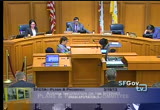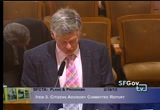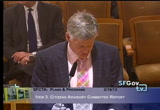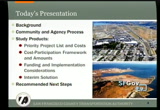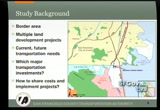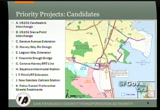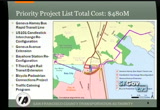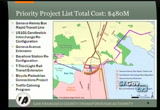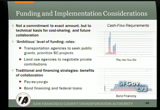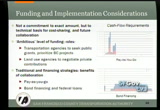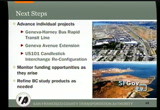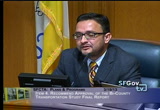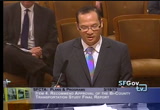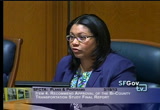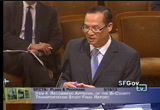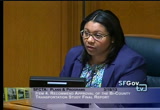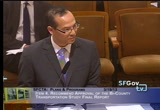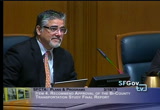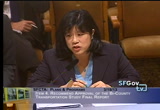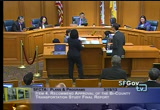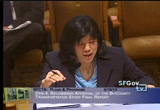tv [untitled] March 23, 2013 4:00am-4:30am PDT
4:00 am
rant eucalyptus trees, special dates and memorable proposals. it is the perfect picnic spot to relax with that special someone by listening to water and fountain in the lagoon and gazing as the swans go gracefully by. beautiful to view from many locations along the lagoon and inside the columns is an ideal place to walk around with your loved one. the palace of fine arts is the most popular location in the city arts system. reservations for weddings and other events a>
4:01 am
>> the meeting will come to order. good morning everyone. this is tuesday march 19, of the plans and programs committee of transportation authority. to my right is the supervisor jim kim and supervisor and commissioner. our clerk is miss erica chang. can you give us announcements? >> there are no announcements. >> thank you, seeing no comments, let's open this up for comment. is there anyone from public who would like to speak? seeing none, let's close. can we prove the minutes
4:02 am
without objection. >> this is an information item. >> looks like we have brian from the advisory committee. >> yes. i apologize commissioners that our chair, our vice-chair couldn't make it. so you got me instead. we on our agenda have three of your action items all of this pass unanimously. we had no. 4 support our approval by county transportation study final report. we probably would have had more discussion on that had friend, still a member of our committee, but she isn't. she may yet show up here to talk about it today. we also had your item no. 5 which is a total of $960,000 in funds for 5 different projects, 3 for d p
4:03 am
w, san francisco state and cal trans. we pass that had unanimously with minimal discussion and the last one we had was 2013 prop case strategic plan and 5 year prioritization plan and pass that had with a minimum amount of discussion, although the 5 programs funded under 5 k lrt, cal train exception the driver replacement only the glert is not. we are disappointed to hear that. the majority of our discussion was not on your agenda was an update of pedestrian strategy of mpa
4:04 am
director for sustainable streets gave a presentation. we are a little disappointed that as a committee that some safety measures like a lot of schools can't be implemented in the near term because of sequel requirements. we wonder if that isn't counterproductive. that's an item on everyone's agenda now i'm sure. that's all we have. >> thank you. colleagues, any questions? thank you so much. this was an informational item. so thank you. let's open this up for public comment. anyone from the public who would like to speak on this item? seeing none, public comment is close. miss cheng please call item no. 4. >> this is an action item.
4:05 am
>> thank you, before mr. fung speaks we are going to hear from mr. david campos. thank you mr. fung. >> good morning, this is the transportation study final report. there is also an enclosure in your packet which is a final report and that final report has brief executive summary, feel free to use that to follow along as i go through my presentation. today i'm going to talk about the background on the study and i will touch on the project. these study projects are in the report but in the interest of time, i will talk about the interested step. this is reference to the southeast
4:06 am
corner and border area of san mateo county where it meets san francisco. in this area there are multiple large development projects being proposed which collectively add of to an amount of new growth and a collection of formal industrial sites to a very vibrant new neighborhood. because the area is a lot vacate and formally industrial area the transportation system is lacking. the two questions that the county study has focused on are one, what are those major transportation investments that are needed to support this square and 2, how do we share the cost among all the partners involved and how do we
4:07 am
implement these projects. there are studies on the san francisco side as well as the san mateo county. there are also private developers looking to develop these sites and of course the over all community. so the study included ways to incorporate input from each of these stake holders groups throughout the process. we didn't start from scratch. there are a number of transportation i am improvements that had been proposed in the area. some by the developments themselves, some of them are projects, some of them are roadway i mprovements. some are closer and some further away. the first task of the city is to look at what are the subset projects that are of interest
4:08 am
so that all partners will join us in this project. the study applies a series of screening and test to make shir there is first of all enough connection to the new development and second of all enough benefits to both sides of the county line. we are able to draw upon the model that the authority makes and where the trips are going and coming from and going to. so if a candidate project made it through that list of screens, then it became what we call a priority project. this slide, next slide shows the projects that made it through that set of test. it's a list of about $480 million worth of projects. handful of major
4:09 am
capital investments, a transit line, a reconfiguration of 101 interstate counter point, an extension of a new local road, the geneva extension and reconfiguration of the cal trans station. first there are several really intertwined together. it's hard to implement one without the other and then the second noted that geographically some of these projects are located on the bridge of bay land which is part of land that is being proposed for development but for which no decision has been made yet so we don't know what will be built there from a land use per expect perspective and some final key aspects. we acknowledge that this is in isly ly necessarily a snapshot
4:10 am
in time and continuous to be made on the land use side. the second major question that the study worked to answer was the question of given the list of projects how do we share the projects, what are our contribution amounts from the land use distribution and the transportation agency and the private side as well. to answer your question, the study used the cost participation framework to have a basis for this conversation. we drew on the model to give us insight to where trips are going and coming from and going to in the future and what the growth is in the future. they approach being that if there is a trip on the network in the future that comes from one of these new developments, that development would take responsibility for and if there is a trip on the network that comes outside of those
4:11 am
developments then the public agencies would take responsibility for that trip. if we go through the area and tally up the trip contribution in this study area and trace them back to the development and the land uses around, we are able to get trip percentages and if we apply that to the $480 million project cost then we start to see the percentages that's get an attributed and what we see in our calculation is a public share of about one-third. that will be shared between san mateo and san francisco jurisdiction and private share of about 2 thirds. that will be divide among the land use proposal. note this document does not represent a commitment to a particular and exact funding amount. rather it's not the intention. the intention is to provide that technical bays on basis to which to have
4:12 am
conversation on future collaboration. so the report discusses some of the requirements and invokation from various strategies and collaboration into the cost sharing. for instance with respect to the funding strategies, we can pay as we go, meaning we built the projects as we are able to assemble the fund or if we are able to lineup funding commitments and like i said, this document does not represent actual commitment, but if we are able to line them up we are better able to take advantage of them collectively and increasing federal loan programs that would allow us to reduce cash flow in any given year and maybe spread oit the payments among a longer time period. i want to talk briefly about
4:13 am
the interest solution that this study created as well. some of the developments are ready to move forward today. particularly in san francisco. another have not yet had land use decisions made or approvals provided so they are not yet ready to move forward. there will be some time p erred period where the development will be online but not all of them. there will be some demand but not the full demand. the idea to the solution is that subset to the priority list could still fill the needs in the interim but a much capital lower cost. finally some next steps we know that we want to advance some individual projects on our priority list including that
4:14 am
geneva transit line. the next item on your agenda today actually includes the question for prop k funds to serve as a local match for a graph that we recently received from the transportation of cal trans to do a study to look at a new east west bus line. we also know that the city of bris bane is looking to move forward with additional design work with the geneva avenue exchange. as you want to monitor the project as it arrives, we may need to refine and revisit some of the by county projects as it continues to evolve and land use decisions are made. that concludes my presentation. an item we are looking for the final improvement. i'm happy to answer questions.
4:15 am
>> thank you, i think this really highlights the transportation authority and bringing together private and public and the community participation is very strong in seeing this process. commissioner campos. >> thank you mr. chairman, i know we are joined by the authority as well. thank you for an excellent presentation. i just had a couple questions. what does it mean to approve this plan? what is the commitment by making this approval. i know that it's $480 million, did you does it mean that we are commit to that
4:16 am
amount and what is the difference between san francisco and san mateo. >> to answer this question this is not a commitment to a $480 million project list. the in investment is to look into what the needed in this area and how we can fund then. the technical participation framework that allows us to talk with our partners about what are appropriate levels of contribution from each party. i think the message here is that as a transportation agency, if we are interested in supporting these investments in this area we have to think about the products in this list in addition to the rest of citywide priorities as we take a look at our priorities citywide. with respect to the
4:17 am
second question about the breakdown between the partners, i will direct you to the final reports executive summary which shows the percentages on page 7 of 78. it shows san francisco percentage of about 19 percent. bris baen about 11 percent and daley city about 3 percent. >> thank you, i just had a question about public involvement specifically one of the challenges that we are dealing with now with regards to the masonic boulevard project what was the it was an approved and there was a huge community process in the area and i'm getting significant number of e-mails and phone calls about the outreach efforts. so i am concerned when
4:18 am
making any sort of improvement to a specific plan that the outreach was sufficient and just wanted to know the details of the outreach because it talks about specifically what you have done, but not necessarily how you did it? >> sure, throughout our process we visited existing community groups. we hosted a workshop that allowed the community to come and see the proposed project, transportation project. we've also been partnering with the land use agencies in the area as the land developments have been going through their outreach processes they have had meetings and created citizen advisory committees and given them presentations on the transportation side of things. and also for the individual projects that we have identified, we do expect that
4:19 am
each of the those projects will have projects of their own as they continue to development the transit fees ability is the next step. in creating an advisory committee that will be appointed from some members of san mateo and san francisco county. >> has there been mail, door to door outreach. because i know in many cases specifically with the masonic boulevard project the complaint was that people were not receiving anything in the mail and not everyone in the neighborhood directly involved with community groups and there is also a language barrier, i'm sure, so i just wanted to know what were the effort around being very
4:20 am
aggressive about the outreach. >> we did do mailings and flyers. >> can you go back to the mailings? how was the mail decided in terms of the outreach? >> you mean -- >> the notifications that might have been sent in the mail, were they sent to everybody within the area. how was that decided. i just want to know specifics. >> it was a big area. we had to hit the radius. if you go to the map it covers a wide range. we tried to focus on the neighborhoods that would be most affected by the project for instance the alignment of the new bus line, the location of the interchange and the new local road. so we targeted to where the projects would be
4:21 am
proposed. >> deputy for planning. this is already just an opportunity to remind us that this is a policy level planning and not a project level effort the way the masonic effort was to develop a particular implementation project. i think the appropriate amount of outreach is you can never do enough but we did do multilevel language outreach to different groups. as in any specific capital projects you will have detailed project outreach where it's more door to door and direct flyering. >> this is the first step and i do understand that and i want to make sure we don't run into the same situation. i know this plan is under way for the past 4 years. i want to make sure we cover all of our basis. >> thank you. >> we have our chair, john
4:22 am
avls. >> can you elaborate on the geneva transit project that's being envisioned in this. i know there is a light rail, was that considered? >> i can talk about the feasiblity study and what that project is going to evolve to. the question about that light rail, we know it's a desire stated in the community and we have partnered with the mta about that idea and we'll look at the issue of can we put light rail on geneva and will it have the ability and be able
4:23 am
to move light car vehicles between the yard and where they start their runs and is there ability to provide services there. we'll be looking at that and moving forward on it shortly. >> is that separate from geneva public transit? >> that's going to be a question that's look at as part of -- the study will look comprehensiveively between what is the potential relationship between bus rail and light transit. if we are looking to offer bus service on geneva avenue, are there synergy and can we perhaps run the light rail and can there be buses in that right of way and i think there is some additional thinking that can be done there. >> sorry, to jump in again. the
4:24 am
ideas in the near term and in the long-term to look at the rail over lay. >> then, this is a bicounty transportation study. is there any approval that san mateo county is providing there? >> our agreement is that this study is essentially being co-led by the two management agencies, the authority here in san francisco and the agency called the city county association of government of san mateo county. >> okay. thank you. >> i just had a question about a potentially controversial issue on the bay shore cal trans station on the san mateo county side and different
4:25 am
efforts to look into moving it into san francisco side north and can you talk about that issue? >> sure. so the topic you are talking about is the idea to move that bay short cal trans station north from where it is now into san francisco? and we understand that that is an idea that has been put out there. it has been made pretty clear to us that it's not necessarily and idea that would benefit them and for efforts that are jointly funded and efforts that are looking to what are joint benefits to both counties, we would look at ideas that would jointly benefit the counties. while we understand that that idea is something that san francisco is interested in moving forward with and with
4:26 am
the authority staff were interested in finding opportunities to look at that and move that idea forward, we are not going to enter that into joint effort we have with san mateo county to preserve relationships and respect the process that has been thus far conducted to come up with a jointly agreed upon planning effort. >> okay. thank you. >> miss cheng. >> there has certainly been some interest on the san francisco side and from our mayor's office they are looking at a separate planning effort around the site to explore those options of including moving the station up northward but that would not be part of the this study. that would only be a san francisco study. as we note before any possibility of
4:27 am
doing that would involve much more of the brt link, a whole issue of transportation issues. >> since the goal of transforming this whole area which involves not only -- which we don't know what's going to happen to point and the executive part that is being developed. we should look at every option and hopefully we can put self interest aside and look at the whole interest as a whole. but look at that project as a separate study. >> thank you. commissioner breed had a question? >> okay. thank you so much. >> if you don't mind a final note. i want to thank chester from our transportation authority team. this effort has
4:28 am
been really exciting on the part of the two, multiple staff have worked on it and even ten years prior with jose louis himself looking at the additional bicounty with san mateo. we do think the lasting value of the methodology and hopefully this project will come to fruition. it links all three cities. on the west side we see other applications with the san francisco state and sharing with the city and the 2 counties on the infrastructure side and the pier 70 where we have multiple stake holders and potential contributors to solution in partnership with
4:29 am
the city. thank you. >> if there are no other questions, thank you so much. let's open this up for public comment. is there anyone from the public that would like to speak? please come forward and 3 minutes max. >> good morning commissioners. my name is jonathan short. general manager of the universal paragon. we have a major land holder in the area. we have been involved in this process since it's inception first i want to compliment staff for their fine work in this area. it's really a difficult process to steward particularly when there are different technical methodologies and development priorities on boetsd both sides of the county line and also want to thank stuff for including the
45 Views
IN COLLECTIONS
SFGTV: San Francisco Government Television Television Archive
Television Archive  Television Archive News Search Service
Television Archive News Search Service 
Uploaded by TV Archive on

 Live Music Archive
Live Music Archive Librivox Free Audio
Librivox Free Audio Metropolitan Museum
Metropolitan Museum Cleveland Museum of Art
Cleveland Museum of Art Internet Arcade
Internet Arcade Console Living Room
Console Living Room Books to Borrow
Books to Borrow Open Library
Open Library TV News
TV News Understanding 9/11
Understanding 9/11
